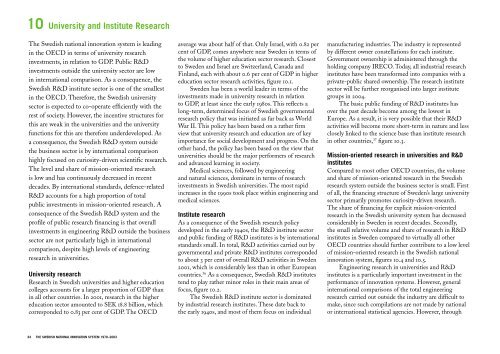The Swedish National Innovation System 1970-2003 - Vinnova
The Swedish National Innovation System 1970-2003 - Vinnova
The Swedish National Innovation System 1970-2003 - Vinnova
You also want an ePaper? Increase the reach of your titles
YUMPU automatically turns print PDFs into web optimized ePapers that Google loves.
10 University and Institute Research<br />
<strong>The</strong> <strong>Swedish</strong> national innovation system is leading<br />
in the OECD in terms of university research<br />
investments, in relation to GDP. Public R&D<br />
investments outside the university sector are low<br />
in international comparison. As a consequence, the<br />
<strong>Swedish</strong> R&D institute sector is one of the smallest<br />
in the OECD. <strong>The</strong>refore, the <strong>Swedish</strong> university<br />
sector is expected to co-operate efficiently with the<br />
rest of society. However, the incentive structures for<br />
this are weak in the universities and the university<br />
functions for this are therefore underdeveloped. As<br />
a consequence, the <strong>Swedish</strong> R&D system outside<br />
the business sector is by international comparison<br />
highly focused on curiosity-driven scientific research.<br />
<strong>The</strong> level and share of mission-oriented research<br />
is low and has continuously decreased in recent<br />
decades. By international standards, defence-related<br />
R&D accounts for a high proportion of total<br />
public investments in mission-oriented research. A<br />
consequence of the <strong>Swedish</strong> R&D system and the<br />
profile of public research financing is that overall<br />
investments in engineering R&D outside the business<br />
sector are not particularly high in international<br />
comparison, despite high levels of engineering<br />
research in universities.<br />
University research<br />
Research in <strong>Swedish</strong> universities and higher education<br />
colleges accounts for a larger proportion of GDP than<br />
in all other countries. In 2001, research in the higher<br />
education sector amounted to SEK 18.8 billion, which<br />
corresponded to 0.83 per cent of GDP. <strong>The</strong> OECD<br />
average was about half of that. Only Israel, with 0.82 per<br />
cent of GDP, comes anywhere near Sweden in terms of<br />
the volume of higher education sector research. Closest<br />
to Sweden and Israel are Switzerland, Canada and<br />
Finland, each with about 0.6 per cent of GDP in higher<br />
education sector research activities, figure 10.1.<br />
Sweden has been a world leader in terms of the<br />
investments made in university research in relation<br />
to GDP, at least since the early 1980s. This reflects a<br />
long-term, determined focus of <strong>Swedish</strong> governmental<br />
research policy that was initiated as far back as World<br />
War II. This policy has been based on a rather firm<br />
view that university research and education are of key<br />
importance for social development and progress. On the<br />
other hand, the policy has been based on the view that<br />
universities should be the major performers of research<br />
and advanced learning in society.<br />
Medical sciences, followed by engineering<br />
and natural sciences, dominate in terms of research<br />
investments in <strong>Swedish</strong> universities. <strong>The</strong> most rapid<br />
increases in the 1990s took place within engineering and<br />
medical sciences.<br />
Institute research<br />
As a consequence of the <strong>Swedish</strong> research policy<br />
developed in the early 1940s, the R&D institute sector<br />
and public funding of R&D institutes is by international<br />
standards small. In total, R&D activities carried out by<br />
governmental and private R&D institutes corresponded<br />
to about 3 per cent of overall R&D activities in Sweden<br />
2001, which is considerably less than in other European<br />
countries. 36 As a consequence, <strong>Swedish</strong> R&D institutes<br />
tend to play rather minor roles in their main areas of<br />
focus, figure 10.2.<br />
<strong>The</strong> <strong>Swedish</strong> R&D institute sector is dominated<br />
by industrial research institutes. <strong>The</strong>se date back to<br />
the early 1940s, and most of them focus on individual<br />
manufacturing industries. <strong>The</strong> industry is represented<br />
by different owner constellations for each institute.<br />
Government ownership is administered through the<br />
holding company IRECO. Today, all industrial research<br />
institutes have been transformed into companies with a<br />
private-public shared ownership. <strong>The</strong> research institute<br />
sector will be further reorganised into larger institute<br />
groups in 2004.<br />
<strong>The</strong> basic public funding of R&D institutes has<br />
over the past decade become among the lowest in<br />
Europe. As a result, it is very possible that their R&D<br />
activities will become more short-term in nature and less<br />
closely linked to the science base than institute research<br />
in other countries, 37 figure 10.3.<br />
Mission-oriented research in universities and R&D<br />
institutes<br />
Compared to most other OECD countries, the volume<br />
and share of mission-oriented research in the <strong>Swedish</strong><br />
research system outside the business sector is small. First<br />
of all, the financing structure of Sweden’s large university<br />
sector primarily promotes curiosity-driven research.<br />
<strong>The</strong> share of financing for explicit mission-oriented<br />
research in the <strong>Swedish</strong> university system has decreased<br />
considerably in Sweden in recent decades. Secondly,<br />
the small relative volume and share of research in R&D<br />
institutes in Sweden compared to virtually all other<br />
OECD countries should further contribute to a low level<br />
of mission-oriented research in the <strong>Swedish</strong> national<br />
innovation system, figures 10.4 and 10.5.<br />
Engineering research in universities and R&D<br />
institutes is a particularly important investment in the<br />
performance of innovation systems. However, general<br />
international comparisons of the total engineering<br />
research carried out outside the industry are difficult to<br />
make, since such compilations are not made by national<br />
or international statistical agencies. However, through<br />
34 THE SWEDISH NATIONAL INNOVATION SYSTEM <strong>1970</strong>–<strong>2003</strong>

















